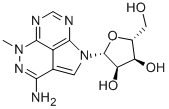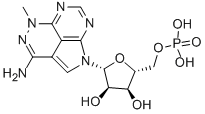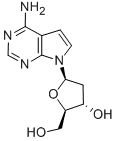API-2
Synonym(s):TCN;API-2;MIHC;MYHL;MYO1A
- CAS NO.:35943-35-2
- Empirical Formula: C13H16N6O4
- Molecular Weight: 320.3
- MDL number: MFCD00932413
- SAFETY DATA SHEET (SDS)
- Update Date: 2024-11-19 23:02:33

What is API-2?
Chemical properties
Off-White Solid
The Uses of API-2
Triciribine is an antitumor tricyclic nucleoside. Triciribine acts as a potent, small-molecule inhibitor of AKT phosphorylation in subjects with solid tumors contining activated AKT. Triciribine is also a selective inhibitor of HIV-1 and HIV-2, including strains known to be resistant to AZT or TIBO.
The Uses of API-2
Triciribine hydrate has been used to study the effect of diethyldithiocarbamate (DDC) on matrix metalloproteinase-1 (MMP-1) in hepatic stellate cells1. It has also been used to analyze ADAM 10 activation by (-)-epigallocatechin-3-gallate (EGCG) in N2a cells overexpressing Swedish mutant APP (SweAPP N2a cells)2.
What are the applications of Application
Triciribine is a tricyclic nucleoside that induces apoptosis and has antineoplastic and antiviral activity
Definition
ChEBI: Triciribine is a nucleoside analogue in which the nucleobase portion is a 1,4,5,6,8-pentaazaacenaphthylene ring system substituted with an amino group at position 3, and a methyl group at position 5 and is bound to the beta-D-ribofuranosyl moiety by an N(1)-glycosidic linkage. It has a role as an EC 2.7.1.137 (phosphatidylinositol 3-kinase) inhibitor.
Biological Activity
Selective inhibitor of Akt (protein kinase B) signaling; displays minimal inhibition of PKC, PKA, SGK and p38 pathways. Inhibits phosphorylation and activation of downstream targets of Akt including Bad, GSK-3 β and AFX. In vitro, induces apoptosis and growth arrest preferentially in human cancer cells with elevated levels of Akt. In mice, potently and selectively inhibits growth of Akt-overexpressing tumors. Inhibits DNA synthesis and displays antiviral activity against HIV-1 and -2.
Biochem/physiol Actions
Triciribine is a highly selective Akt/PKB inhibitor, that selectively inhibits the cellular phosphorylation/activation of Akt1/2/3.
storage
Store at RT
Properties of API-2
| Melting point: | 207 °C (decomp) |
| Boiling point: | 459.21°C (rough estimate) |
| Density | 1.2633 (rough estimate) |
| refractive index | 1.7000 (estimate) |
| storage temp. | Store at RT |
| solubility | DMSO: >10mg/mL |
| pka | 12.35±0.70(Predicted) |
| form | powder |
| color | tan |
Safety information for API-2
| Signal word | Warning |
| Pictogram(s) |
 Exclamation Mark Irritant GHS07 |
| GHS Hazard Statements |
H317:Sensitisation, Skin H319:Serious eye damage/eye irritation |
| Precautionary Statement Codes |
P280:Wear protective gloves/protective clothing/eye protection/face protection. P305+P351+P338:IF IN EYES: Rinse cautiously with water for several minutes. Remove contact lenses, if present and easy to do. Continuerinsing. |
Computed Descriptors for API-2
| InChIKey | HOGVTUZUJGHKPL-HTVVRFAVSA-N |
New Products
(S)-3-Aminobutanenitrile hydrochloride 4-Methylphenylacetic acid N-Boc-D-alaninol N-BOC-D/L-ALANINOL Tert-butyl bis(2-chloroethyl)carbamate 3-Morpholino-1-(4-nitrophenyl)-5,6-dihydropyridin- 2(1H)-one Furan-2,5-Dicarboxylic Acid Tropic acid 1-Bromo-3,5-Di-Tert-Butylbenzene S-2-CHLORO PROPIONIC ACID ETHYL ISOCYANOACETATE 2-Bromo-1,3-Bis(Dimethylamino)Trimethinium Hexafluorophosphate 4-IODO BENZOIC ACID 3-NITRO-2-METHYL ANILINE 1-(2,4-DICHLOROPHENYL) ETHANAMINE (2-Hydroxyphenyl)acetonitrile 4-Bromopyrazole 2-(Cyanocyclohexyl)acetic acid 4-methoxy-3,5-dinitropyridine 1-(4-(aminomethyl)benzyl)urea hydrochloride 2-aminopropyl benzoate hydrochloride diethyl 2-(2-((tertbutoxycarbonyl)amino) ethyl)malonate tert-butyl 4- (ureidomethyl)benzylcarbamate Ethyl-2-chloro((4-methoxyphenyl)hydrazono)acetateRelated products of tetrahydrofuran

![4-Amino-7H-pyrrolo[2,3-d]pyrimidine](https://img.chemicalbook.in/CAS/GIF/1500-85-2.gif)






You may like
-
 Akt Inhibitor V, Triciribine CAS 35943-35-2View Details
Akt Inhibitor V, Triciribine CAS 35943-35-2View Details
35943-35-2 -
 Akt Inhibitor V, Triciribine CAS 35943-35-2View Details
Akt Inhibitor V, Triciribine CAS 35943-35-2View Details
35943-35-2 -
 1975-50-4 98%View Details
1975-50-4 98%View Details
1975-50-4 -
 2-HYDROXY BENZYL ALCOHOL 98%View Details
2-HYDROXY BENZYL ALCOHOL 98%View Details
90-01-7 -
 2-Chloro-1,3-Bis(Dimethylamino)Trimethinium Hexafluorophosphate 221615-75-4 98%View Details
2-Chloro-1,3-Bis(Dimethylamino)Trimethinium Hexafluorophosphate 221615-75-4 98%View Details
221615-75-4 -
 61397-56-6 CIS BROMO BENZOATE 98%View Details
61397-56-6 CIS BROMO BENZOATE 98%View Details
61397-56-6 -
 14714-50-2 (2-Hydroxyphenyl)acetonitrile 98+View Details
14714-50-2 (2-Hydroxyphenyl)acetonitrile 98+View Details
14714-50-2 -
 118753-70-1 98+View Details
118753-70-1 98+View Details
118753-70-1